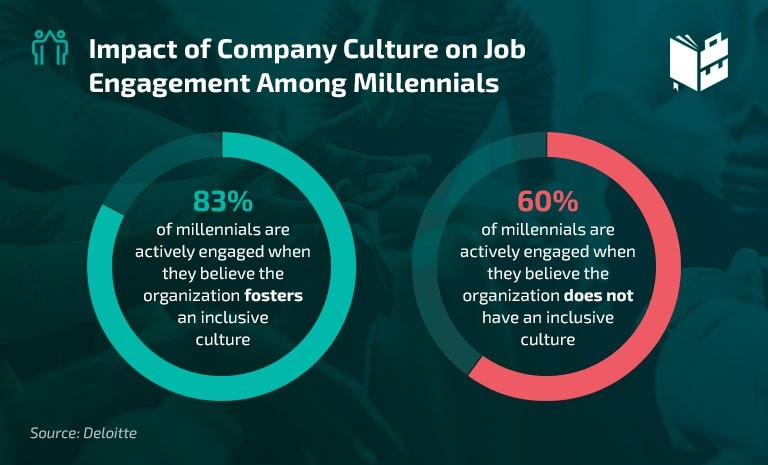
Why Diversity-Focused Recruiting is the Key to Business Success? Complete Guide
In today's world, building a diverse and inclusive team has become more important than ever. Not only does it make good business sense, but it also helps foster a positive workplace culture where everyone feels valued and respected.
You can get the idea of diverse and inclusive culture from the recent survey of Deloitte, that 83% of the millennials feels to get actively engaged in those organizations those who support it.

But where do you start? How do you go about building a team that represents a range of backgrounds, experiences, and perspectives? That's where these five proven strategies come in.
From casting a wide net when recruiting to fostering open communication and embracing differences, these strategies will help you build a team that is both diverse and inclusive. So whether you're a small business owner or a manager in a larger organization, read on to discover how you can take practical steps towards creating a more diverse and inclusive workplace.
In addition, if you’re looking to know more tips and strategies to run your organization more effectively than we do suggest you go through our MA in Education with Learning & Development which will be quite beneficial to you. Now let’s get in straight to the topic for which you’re here.
Understanding Diversity and Inclusion
Before we dive into the strategies, it's important to understand what diversity and inclusion mean. Diversity refers to the range of differences that exist among people, including but not limited to race, ethnicity, gender, age, religion, sexual orientation, and physical abilities. Inclusion, on the other hand, is about creating a workplace culture that values and respects all individuals and their differences. It's about fostering an environment where everyone feels included, heard, and valued.
Achieving diversity and inclusion requires a commitment from everyone in the organization, from the leadership team to individual employees. It's not something that can be achieved overnight or with a one-time initiative. Rather, it requires a sustained effort to create a culture of inclusion that permeates every aspect of the organization.
Benefits of a Diverse and Inclusive Team
Building a diverse and inclusive team has numerous benefits, both for the organization and its employees. Research has shown that diverse teams are more innovative, creative, and better problem-solvers than homogenous teams. They bring a variety of perspectives and experiences to the table, which can lead to better decision-making and more effective solutions.
In addition, a diverse and inclusive team is more likely to attract and retain top talent. People want to work for organizations that value diversity and inclusion, and they are more likely to stay with those organizations when they feel included, respected, and valued.
A diverse and inclusive team can help improve the bottom line. According to a study by McKinsey & Company, companies with more diverse executive teams are more likely to have higher financial returns than those with less diverse teams.
5 Proven Strategies for Building a Diverse and Inclusive Team
Now that we understand the importance of diversity and inclusion, let's explore five proven strategies for building a diverse and inclusive team.
1. Establishing a D&I Committee
One effective way to create a culture of inclusion is to establish a diversity and inclusion (D&I) committee. This committee should be made up of employees from all levels of the organization, including leadership, and should be responsible for developing and implementing strategies to promote diversity and inclusion.
The committee should meet regularly to discuss progress, identify areas for improvement, and make recommendations for changes in policies, procedures, and practices. They should also be responsible for educating employees about the importance of diversity and inclusion, and for promoting awareness and understanding of different cultures, backgrounds, and experiences.
2. Recruiting from Diverse Talent Pools
Another key strategy for building a diverse and inclusive team is to recruit from diverse talent pools. This means casting a wide net when recruiting and actively seeking out candidates from underrepresented groups.
To do this effectively, it's important to review and revise recruitment practices to eliminate bias and ensure that job postings and application materials are inclusive. This may involve partnering with organizations that represent diverse communities, attending career fairs and networking events, and using social media and other digital platforms to reach a wider audience.
3. Implementing Unconscious Bias Training
Unconscious biases are attitudes or stereotypes that we hold about certain groups of people, often without even realizing it. These biases can influence our decision-making and lead to unintentional discrimination.
To mitigate the impact of unconscious biases, it's important to provide training to employees that raise awareness of these biases and help them recognize and address them. This training should be mandatory for all employees and should cover topics such as implicit bias, microaggressions, and stereotype threat.
4. Creating a Safe and Inclusive Work Environment
Creating a safe and inclusive work environment is essential for building a diverse and inclusive team. This means taking steps to eliminate discrimination, harassment, and bullying, and creating a workplace culture that values and respects all individuals.
To achieve this, it's important to have clear policies and procedures in place that address discrimination, harassment, and bullying, and to provide training to employees on these policies. It's also important to foster open communication and encourage employees to speak up if they witness or experience any form of discrimination or harassment.
Finally, it's important to celebrate and value differences and to create opportunities for employees from diverse backgrounds to share their experiences and perspectives. This can include cultural celebrations, diversity and inclusion workshops, and employee resource groups.
5. Providing Opportunities for Professional Development and Growth
Providing professional development and growth opportunities is another important strategy for building a diverse and inclusive team. This means creating opportunities for all employees to advance their careers, regardless of their background or experience.
To do this effectively, it's important to provide training and development programs that are accessible to all employees and to ensure that promotions and other career advancement opportunities are based on merit and performance, rather than on factors such as gender, race, or ethnicity.
Measuring the Success of Your D&I Efforts
Once you've implemented these strategies, it's important to measure their effectiveness. This will help you identify areas for improvement and make adjustments as needed.
Some key metrics to track include the diversity of your workforce, employee engagement and satisfaction levels, and the representation of diverse groups in leadership positions. It's also important to gather feedback from employees on their experiences and perceptions of the organization's culture and practices.
Challenges and Limitations of D&I in the Workplace
Building a diverse and inclusive team is not without its challenges and limitations. Some of the most common challenges include resistance from employees who may feel threatened by change, lack of leadership buy-in and commitment, and unconscious biases that may be deeply ingrained in the organization's culture.
Other limitations include the difficulty of measuring the impact of D&I initiatives and the potential for tokenism or superficial efforts that do not effectively address the root causes of discrimination and exclusion.
Build a diverse and inclusive environment within organization
Building a diverse and inclusive team is essential for promoting innovation, attracting and retaining top talent, and improving the bottom line. By implementing these five proven strategies, you can take practical steps toward creating a more diverse and inclusive workplace.
Remember, achieving diversity and inclusion requires sustained effort and commitment from everyone in the organization. But the benefits are well worth the effort and will help create a workplace culture that values and respects all individuals and their differences.
In case, if you’re a corporate leader or any individual who wants to learn more about unique and essential leadership skills to help an organization grow then we recommend you to go through our MA in Education with Learning & Development, which will definitely help you.

